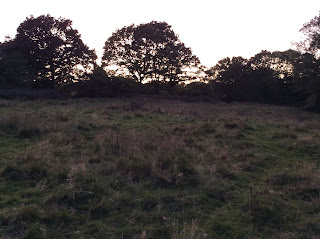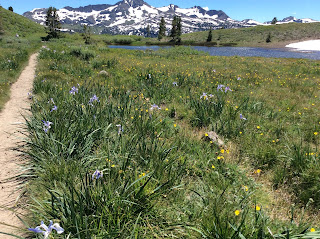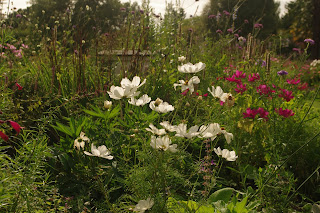A diary of back garden botany, urban ecology, rural rambles and field trips to the middle of nowhere...
Sunday, 29 September 2019
Japanese Anemones provide some late colour in the garden and cope with -in fact prefer- a bit of shade. That's welcome since the shady garden has very little in flower by this point in the year. If you so wish they come in various shades of pink with frilly double flowers but the simplicity of Anemone x hybrida 'Honorine Jobert' is the one for me.
It seems a Monsieur Jobert spotted this hybrid form in his garden in Verdun, France in 1858 and propagated it. Sometimes it's described as a cultivar (i.e. cultivated variety) but arguably it appears to have been a natural hybrid albeit of garden origin.
Japanese Anemones also provide some late foraging for pollinators. However when I looked closely at this hoverfly I noticed that it was being devoured by a blue spider!
Friday, 27 September 2019
Tahoe wildflowers. I saw many clumps of this plant on my hike round the Meiss Meadows back in July. I'm not sure what it is- the flora of North America is very different to the UK but then again it's often possible to discern similarities.
The nodding bell shaped flowers put me in mind of some of the Comfreys (i.e. Symphytum species) though the foliage looks different. This makes me think it might be of the Boraginaceae family. Pulmonarias are also of the Borage family and also have nodding bell flowers which in some cases morph from blue to pink to mauve e.g. the Common Lungwort (P. officinalis).
A number of plants whose flowers undergo this transformation are graced with the common name of Abraham, Isaac and Jacob- presumed to be a reference to the changing colours. In fact all the ones I can think of are fellow Borages. Perhaps the plant I saw in great profusion on the Tahoe trails is an American cousin?
Wednesday, 25 September 2019
The Wessex Ridgeway runs across Dorset beginning (or ending) at Lyme Regis on the coast. It connects with the route known simply as The Ridgeway at West Kennet in Wiltshire to Ivinghoe Beacon in Buckinghamshire. There it becomes the Icknield Way stretching to the north Norfolk coast. These trails date back to prehistoric times and the whole route can still be walked from one side of the country to the other.
The Wessex Ridgeway passes through Kingcombe; on the second day of my visit I used it to head in an easterly direction passing through the villages of Cattistock and Sydling St Nicholas and back again. On the third day I hiked westward ho to the equally picturesque village of Powerstock. Here I took to the lanes to get to Bridport, then caught a bus along the coast towards Weymouth. I'd packed my tent in my rucksack and I pitched for one night on a campsite in Punknowle, a mile or so from the sea.
NB I have written before in this diary about one of my favourite novels: Rogue Male by Geoffrey Household, published in 1939. [See also entry dated 7th. April 2018]
The unnamed protagonist is on the run from enemy agents after a failed attempt to assassinate an unnamed dictator. He goes to ground in the Dorset countryside in an attempt to shake them off. At one point he holes up in the hills above Sydling St Nicholas then makes a dash cross country skirting Cattistock and Powerstock.
Rogue Male is a work of fiction but the author was clearly very familiar with the terrain.
Tuesday, 24 September 2019
The ancient meadows of Kingcombe were the first port of call on my short break to Dorset last week. I stayed in b and b accommodation in the heart of the meadows for the first two nights.
I have visited the meadows before in summer when there is a remarkable display of wildflowers, including many orchids [see my entry of June 13th. 2017]. By September the flowering has largely passed but the wonderful tranquility of the place remains.
It felt very much like the last days of the Indian Summer we've been having, with a tangible sense of autumn in the air. Dusk was particularly evocative of the changing of the seasons; the meadows at twilight were enchanting.
Saturday, 21 September 2019
Tuesday, 17 September 2019
Still getting a couple of handfuls of Runner Beans every week, and they're still flowering (as are the Nasturtiums at ground level). I think they'll keep cropping right up till the first frosts if this Indian Summer continues...
NB Speaking of which I'm heading to Dorset for a few days to catch some rays of this late sunshine so won't be posting any entries till I'm back at the weekend.
Monday, 16 September 2019
The subject of natural dyes featured in a recent post [26/08/19]. Susan and Ashley who have the neighbouring allotment are expert dyers and their website/blog Nature's Rainbow is a mine of information. As I mentioned several of us gathered at their house to do some dyeing; in particular we made Indigo from the leaves of Woad (Isatis tinctoria).
Which reminds me that several years ago I helped some permaculturalists plant a garden of dye plants at Morley College in London which has a highly regarded textiles department. Zoe Burt who teaches there gave a demonstration of dyeing using Weld (Reseda luteola) and we each dyed a silk handkerchief in a luminous shade of yellow.
I read somewhere that if Weld is overdyed with Woad it creates Lincoln Green; I'll have to give that a go sometime.
We generated other colours with Susan and Ashley that day using the flowers of Dahlia, Rudbeckia and also crushed Cochineal. These resulted in various vibrant shades on the yellow/red/orange spectrum.
Plants as a topic generate so many avenues of inquiry: food, medicine, dyes et al. I don't have the time to explore every aspect in the detail it merits but it's fascinating to gain these insights from people who have specialised knowledge.
Saturday, 14 September 2019
Tahoe wildflowers: Indian Paintbrush. The Americas have around 200 species of the Castilleja genus which have the colloquial name of Indian Paintbrush. Most have flowers with fiery red hues of varying tone and certain variations in leaf form. I saw the above for example within a mile or two of each other and there is a noticeable difference in the flower heads: one bright orange, the other deep burgundy.
Even so I look in my reference books and in many cases find it hard to tell one from another. Needless to say they all have their given name in botanical Latin but the common names give a sense of their differences and distribution. Such as: Wavy Leaf Indian Paintbrush, Seashore Indian Paintbrush, Cobwebby Indian Paintbrush, Desert Indian Paintbrush, Scarlet Indian Paintbrush, Harsh Indian Paintbrush, Wholeleaf Indian Paintbrush, Wyoming Indian Paintbrush, Suksdorf's Indian Paintbrush, Sierra Woolly Indian Paintbrush... and dozens more!
Friday, 13 September 2019
Thursday, 12 September 2019
Tahoe wildflowers. I've posted a number of entries describing my hike back in July on the Tahoe Rim Trail and the Pacific Crest Trail. I saw plenty more wildflowers than I've mentioned so far which I'll sift through in the weeks ahead. For example as I walked towards Carson Pass on the PCT I came across this beautiful high mountain meadow dotted with hundreds of Irises.
Wednesday, 11 September 2019
Thursday, 5 September 2019
Can't say I've ever grown them but Cosmos are a half-hardy annual that adds a dash of bright colour to sunny late summer borders.
The wild species are of the Americas but a great many cultivars and hybrids have been developed by plant breeders in many different hues. I saw these recently at the Cambridge Botanical Gardens.
Wednesday, 4 September 2019
Very few plants flower under the shade of trees and shrubs in late summer/early autumn. On the whole shade tolerant plants are woodlanders that bloom in spring before the leaves darken the canopy.
Even so there is colour to be found (I mean besides the colour green). Our native Arum maculatum and its relative Arum italicum both put up a spike of orange/red berries at this time of year.
I saw these in a shady border at the South London Botanical Institute last week; not sure which Arum they are as the leaves have faded by now. Of course not all berries are edible. Succulent as they look Arums are a poisonous plant.
Tuesday, 3 September 2019
Tahoe trails part 10. I saw plenty of lakes during my 10 day hike in the Lake Tahoe area. I camped by Showers Lake for 3 nights and Dardenelles Lake for 3 nights. I passed by Round Lake and walked over to Scott's Lake. I hiked out to Lake Aloha in the Desolation Wilderness via the Lower and Upper Echo Lakes.
One lake I saw very little of was Lake Tahoe although it is one of the largest and deepest in the States. I arrived by bus in the town of South Lake Tahoe on the 19th. of July and left from there on the 28th. but the lake itself was some way away from the South Y Transit Center. My hike into the Meiss Roadless Area took me away from the lake - about 15 miles away at the furthest point. The Meiss Meadows and the surrounding mountains form a watershed that drains into Lake Tahoe.
From time to time I saw a glimpse of Lake Tahoe in the distance. On the first and last two nights I camped near Echo Summit in a spot which offered a splendid vista, as seen above at sunset on the 27th. July. On the horizon is the far rim of the Tahoe basin, a good 20 or 30 miles away. Below that a sliver of blue is just about visible which is the lake glinting in the twilight.
On July 28th. I rose early and hiked back the way I came down the Old Meyers Grade thereby returning to the world of malls, motor vehicles and humanity.
Sunday, 1 September 2019
The tall stems of Purple Loosestrife (Lythrum salicaria) and their vivid inflorescence grow alongside water in late summer. Bees are still hungry but the majority of of flowering plants have peaked and waned by now. Purple Loosestrife provides a valuable source of pollen and nectar for honey bees and long and short tongued bumblebees, butterflies too.
Subscribe to:
Posts (Atom)




















